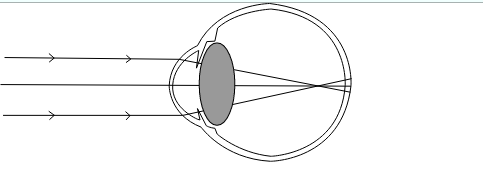
Explain with the help of a labelled ray diagram, the defect of hypermetropia and how it is corrected.
Answer
554.4k+ views
Hint: Hypermetropia is a defect of vision in which the image of the object is not formed on the retina but in front of the retina. It is also called long sightedness. Usually for a healthy eye, it is able to see up to infinity but when it becomes weak due to stress and strain the far point decreases. Similarly, the near point up to which an object can be clearly seen is 25 cm.
Complete step by step answer:
In case of hypermetropia the image of an object is not formed on the retina but Infront of the retina, as shown below.

We can see that the light rays coming from the infinity gets converged Infront of the retina but we want them to get focuses on the retina, thus in order to rectify this defect of eye we use a diverging lens that is concave lens which diverges the incoming light rays, then after passing through it they passes through the lens of the eye and finally converges onto the retina. This can be shown below.

Note:
The major cause of the hypermetropia is that the focal length of the eye lens increases and as a result of it the light rays converge in front of the retina. Another cause can be that the eyeball itself becomes too small. To correct this defect, we use a concave lens of appropriate focal length. In Farsightedness one can see distant objects but cannot see nearby objects.
Complete step by step answer:
In case of hypermetropia the image of an object is not formed on the retina but Infront of the retina, as shown below.

We can see that the light rays coming from the infinity gets converged Infront of the retina but we want them to get focuses on the retina, thus in order to rectify this defect of eye we use a diverging lens that is concave lens which diverges the incoming light rays, then after passing through it they passes through the lens of the eye and finally converges onto the retina. This can be shown below.

Note:
The major cause of the hypermetropia is that the focal length of the eye lens increases and as a result of it the light rays converge in front of the retina. Another cause can be that the eyeball itself becomes too small. To correct this defect, we use a concave lens of appropriate focal length. In Farsightedness one can see distant objects but cannot see nearby objects.
Recently Updated Pages
Master Class 12 Business Studies: Engaging Questions & Answers for Success

Master Class 12 Economics: Engaging Questions & Answers for Success

Master Class 12 English: Engaging Questions & Answers for Success

Master Class 12 Maths: Engaging Questions & Answers for Success

Master Class 12 Social Science: Engaging Questions & Answers for Success

Master Class 12 Chemistry: Engaging Questions & Answers for Success

Trending doubts
What are the major means of transport Explain each class 12 social science CBSE

Which are the Top 10 Largest Countries of the World?

Draw a labelled sketch of the human eye class 12 physics CBSE

How much time does it take to bleed after eating p class 12 biology CBSE

Explain sex determination in humans with line diag class 12 biology CBSE

Differentiate between homogeneous and heterogeneous class 12 chemistry CBSE




